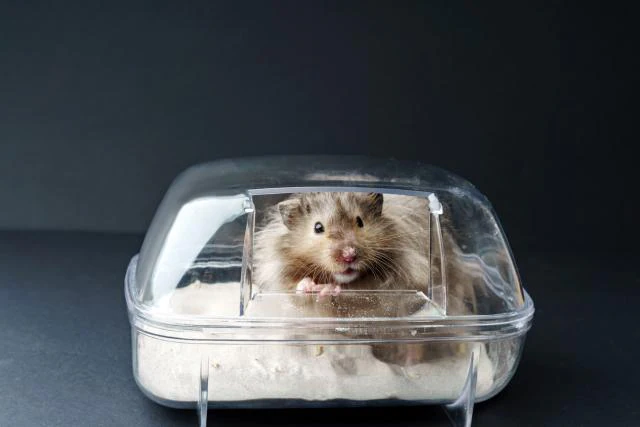Do you have questions about how to properly clean your hamster using a sand bath? Or perhaps you might consider providing your hamster with one so that it can have some fun.
Sand baths are an excellent method that does not in any way endanger the health of hamsters and can effectively eliminate filth and unpleasant odours from their habitats.
This guide to sand bathing, which has been thoroughly studied, will teach you everything that you need to know about utilising sand baths to keep your hamster as clean and fresh as possible.
There are a number of steps involved in bathing your hamster –
- Choosing the correct sand and bath dish.
- When the dish is filled to the brim with the correct bath sand.
- Placed the dish in the hamster’s cage corner.
So, how do you select the correct sand and bath dish? The frequency of sand baths is also an important question.
Additional questions that may be relevant to your hamster’s species have been included in this comprehensive guide.
Read on to find out the answers to all of these questions and more!
What is a hamster sand bath?
In comparison to the typical type of bath we might give our dogs, a sand bath is a unique experience.
An appropriate amount of pet-safe sand is placed in a shallow container that your hamster can easily access. Large enough to roll around in, as well.
Your hamster will roll around and play in the sand instead of using soap and water to remove dirt from its fur. This helps to clean their fur by removing grease and grime.
This video of two adorable dwarf hamsters taking a sand bath may help you visualize what I’m talking about.
Do hamsters need sand baths?
Hamsters keep themselves clean by self-grooming, and they should do so on a regular basis.
As long as their kennels are kept clean and their bedding is changed on a regular basis, they should be fine.
However, no matter how clean their surroundings are, there is always the possibility that their fur will get a little dirty or oily.
Because they dislike water and will avoid it if, given the choice, most hamsters should not be given baths.
Check with a vet if you’re concerned about the cleanliness of your hamster’s health .’s For example, if it begins to emit an overpowering odour, or if its fur appears unkempt.
To keep your hamster’s fur clean, your veterinarian may advise you to use a sand bath.
Hamsters shouldn’t require sand baths because they clean themselves naturally. Giving your hamster a sand bath, on the other hand, can actually assist in its self-cleaning.
Additionally, while hamsters can take sand baths, it is not a good idea to give them a dust bath because it could cause respiratory problems in your pet.
Do hamsters like sand baths?
There are many types of animals that enjoy playing in the sand, especially those that have fur.
If your hamster isn’t interested in a sand bath, you may need to try something else.
Whether Syrian or Dwarf, sand bathing is a favourite pastime for hamsters depending on the species.
Compared to Syrian hamsters, dwarf hamsters appear to prefer sand baths. However, this is not a universal rule for hamsters.
Sand bathing can be an easy way to keep your pet entertained if he or she enjoys it. And it’s a great way to get some exercise for it, too!
How do you give a hamster a Sand Bath?
You should never give your hamster a bath in water, but there is another option you should know about in case your pet starts to smell.
Hamsters have a natural urge to roll around in the sand because that’s what they do in the wild to stay clean. Hamster owners can do the same thing in their own homes.
It is important for a hamster’s health that its owner thinks carefully about these things and only buys the best products.
The sand bath is easy to set up, and it only takes a couple of minutes before it’s ready to go in your hamster’s cage.
Follow these short, step-by-step instructions to set up the dish quickly and easily so bath time can start.
- Clean the bathing dish thoroughly, making sure that it is totally dry before use.
- Using a tablespoon, fill the dish with around 10 tablespoons of your chosen chinchilla/hamster/reptile sand.
- Place the sand bath in the cage, preferably in a corner to minimize the amount of sand that gets kicked around and outside of the bath.
See?
It’s easy!
The sand might be dirty after the hamster is done bathing. It should be taken out of the cage right away so that it doesn’t start to smell.
How do I Choose the Right Sand for Their Bath?

In the wild, hamsters will dig holes in the sand or coarse dirt and roll around in them to clean their skin and fur.
Commercial sand bathing products can be bought online or at a pet supply store near you.
The sand’s big grains are rough enough to get rid of dirt and other grime from the hamster’s body without having to use water, which can make them more likely to get sick.
If you choose the right kind of sand, the sand will also soak up oil and moisture from the skin.
Small pets like hamsters and chinchillas can use the bath to keep their skin and fur in good shape.
The bath sand is made of all-natural ingredients that won’t irritate the skin or fur.
How do I know which dish is best for their sand bath?
There are a few things you should look at to decide if a dish is good for your hamster’s sand bath. When you’re out shopping, ask yourself these questions to help you decide:
- Would my hamster topple this dish over as they get in or out?
- Does the shape of the dish make it easy for sand to get stuck in the corners or edges?
- Is the dish too tall for my hamster to get in and out easily?
- Is the dish wide enough for my hamster to roll around freely?
Dishes in the shape of a wok are very popular because they are stable, don’t have corners, and have a deeper centre that hamsters like to roll around in.
But almost any short and wide container could be used for this.
How Sand Baths Work
In the wild, animals often use sand and dirt to clean themselves. Sand is naturally rough and can be used as a bath instead of water by animals that would be hurt by getting wet.
When your hamster rolls around in the sand bath, its fur gets roughed up, which rubs off any extra dirt.
The sand itself soaks up the skin and coat’s extra oil and moisture.
Hamster Grooming Needs
The coats of hamsters, especially those with long hair, should be brushed often. Pay extra attention to tangled hair when you brush your hamster.
Hamsters also need their nails cut every so often, especially as they get older. If your hamster’s nails are too long or look strange, you should call your vet.
At least once every few weeks, check your hamster’s back end for faeces buildup or urine stains and skin growths.
Do All Hamsters Need Sand Baths?
Most hamsters will be fine without ever taking a sand bath, but this is only true if their cage is kept spotlessly clean and they don’t have any health or other physical problems that keep them from grooming themselves well.
Common Sand Bath Problems
As long as you use the right kind of sand and dish for your hamster’s bath, it won’t hurt his or her health.
Still, some hamster owners have had at least one of these two problems with their furry friend:
- Refusal to use the sand bath
- Using the sand bath as a litter box
Most hamsters don’t need much convincing to use their sand bath, but some never really get into it, and that’s fine. Your hamster probably won’t get sick if it doesn’t want to roll around in the sand.
If they don’t look like they want to use it, take the sand bath out of their cage right away. This will stop them from going to the bathroom in the sand.
Conclusion
Hope this article help you understand and answer all question regarding sand bathing your hamster.
If you do want to give your hamster a bath, make sure to check the sand’s ingredients first, because some contain chemicals that can be harmful.
Make sure to give them enough room to burrow, play, and roll around.






